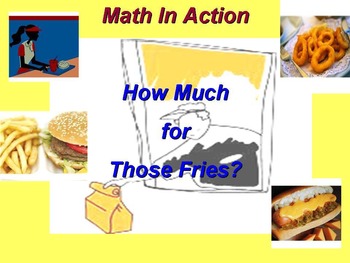How Much for Those Fries? The Math in Action Series.
- PDF
Description
Ever wonder how the price at a "Fast Food" restaurant may be determined. This activity may just answer that question for you.
The application of mathematical theory has always been the "when will I ever use this Real Life" attitude from our students. I created this lesson to reinforce the theory of graphing data, calculating an equation of best fit, and formulating a conclusion. Each student will be able to see the usefulness of mathematics in a Real World setting.
Common core standards include 6NS.C.8, 6EE.C.9, 7EE.B.4a, 7EE.B.4b.
Some additional activities you may wish to check out: (Click on the product you wish to view)
Which is more Cost Effective: Solar Heat or Oil Heat?
Which is more Cost Effective: Solar Heat or Oil Heat?
What Dosage Should I Prescribe?
What Dosage Should I Prescribe?
What Cell Phone Plan Should I Use?
What Cell Phone Plan Should I Use?
Which Speed for Best Gas Mileage?
Which Speed for Best Gas Mileage?
Some additional activities you may wish to check out: (Click on the product you wish to view)
Math in Action Series Book 2
Weather Balloon Launch.
Volcanic Eruptions.
Volcanic Eruptions: part of the Math in Action Series Book 2.
How Fast Can a Cheetah Run?
How Fast Can a Cheetah Run? part of the Math in Action Series Book2.
The Earth’s Temperature.
The Earth's Temperature: part of the Math in Action Series Book 2.
Alligator Growth.
Alligator Growth: part of the Math in Action Series Book 2
A Landfills Lifetime: part of the Math in Action Series, Basic Algebra.
A Landfills Lifetime: part of the Math in Action Series, Basic Algebra.





